Growing
since
1979

FAQ > Trees and Shrubs:
Disease and Insects:

Anthracnose: Anthracnose is a group of foliage diseases that affect most hardwood tree species and is most prevalent and destructive in early spring when moist weather conditions favor disease development. Anthracnose can result in leaf blight, defoliation, and even twig dieback. If left untreated, anthracnose will severely weaken trees, predisposing them to invasion by bores, and secondary disease causing organisms. Anthracnose causes lesions to form on the leaves, and even on flowers of some host trees. Proper pruning practices will allow optimum light and air penetration to the crown, and will inhibit disease development. For severe outbreaks, a properly timed fungicide application will help control anthracnose.
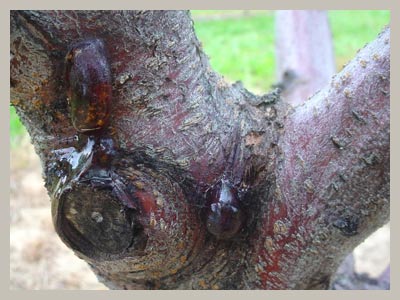
Fire Blight: Blight is foliar disease that affects most pears, crabapples, hawthorns, mountain ash, spirea, and roses. The most common symptom of blight is blackening of the limbs with an appearance it was scorched by fire, and a brown ooze develops at the site of these cankers during moist, warm weather. Blight is a highly contagious disease, and without proper sanitation, it can be spread to other plants very easily. Regular watering, fertilization, and pruning of your trees will keep them as healthy as possible, and will help resist blight. Branch infections should be removed during dry weather in the warm summer months.
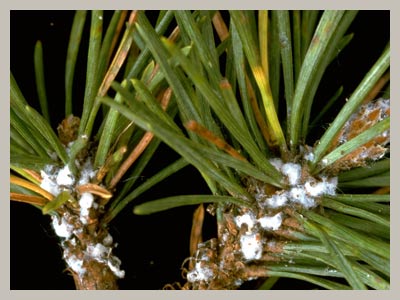
Powdery Mildew: Powdery Mildew is a foliage disease, which occurs on nearly all species of ornamental plants. Foliage, stems, and flowers become covered with a white powdery growth. Although it seldom causes permanent damage, this disease can cause premature defoliation, growth reduction, and generally render the host aesthetically unpleasing. Powdery mildew may occur at any time during the growing season, however, it is usually most severe in the late summer months. Proper fertilization and watering, can help prevent powdery mildew. For severe outbreaks, fungicide sprays will minimize powdery mildew if applied regularly before the infestation first occurs.

Adelgids: Adelgids are aphid-like insects that feed on conifers, and withdraw the sap from the needles of the trees. Infestations can cause growth deformations, die back of branches, and in severe outbreaks it can even result in the death of the host plant. Adelgids can be treated in the summer months with a foliar insecticide treatment.

Aphids: Aphids range in color from yellow, to green, to black, and typically have wings, long antennae and long legs. Aphids can be present on conifers, deciduous trees, and herbaceous plants. Aphids feed on the plants by piercing the leaves, stems, or twigs and then sucking out plant sap. Aphids feed on flowers, flower buds, leaves, stems, branches and bark. They produce a sticky substance that covers leaves and stems. Excessive feeding can lead to a curled or discolored leaves, loss of plant vigor, and can hinder growth. Repeated severe infestations can lead to plant die-back. Aphids can be treated with a foliar insect spray in the spring and fall and as needed throughout the season.
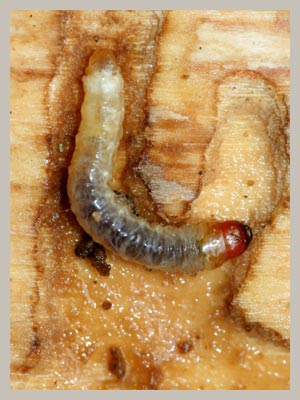
Bores: Boring insects are often the most harmful to trees and if left untreated can be deadly to the trees. In the fall, adult bores lay eggs in the cracks and crevices of the trees and branches. If left untreated, the eggs hatch in the spring, and the larvae burrow deep into the water-conducting tissues of the tree, and feed on the vascular tissues. If the infestation is serious, the upper leaves of the tree are starved of nutrients and moisture and the tree can eventually die. Signs of bore damage includes: exit holes in the bark, small mounds of sawdust at the base, and sections of the crown wilting and dying. Proper watering, fertilization, and pruning of your trees will keep them as healthy as possible, and will help resist attacks from wood borers. Bores can be treated in the spring with a dormant oil application to kill overwintering eggs. If infestation is serious, a systemic insecticide is highly recommended.
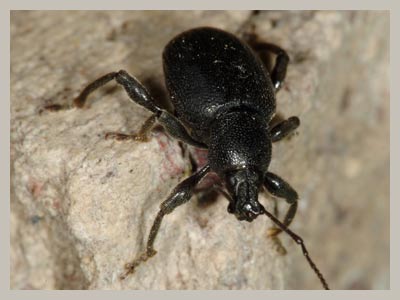
Black Vine Weevil: The black vine weevil feeds on over 100 species of woody and herbaceous plants, feeding on the foliage, causing distinct, easily recognizable notches in the leaf margin. The larva of the black vine weevil inhabits the soil, where they feed on the root system of their hosts. Black vine weevil populations can be treated when adults are actively feeding, and before laying eggs.
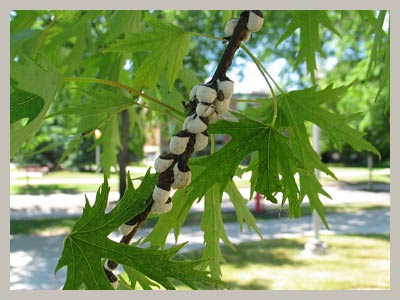
Cottony Maple Scale: The cottony maple scale insect overwinters as an immature female on the leaves and branches of its host plant. With the onset of warm spring temperatures, it grows rapidly, and by late spring the character white egg sac of the female is evident on the trees. The eggs hatch in the summer, and the small insects feed on the leaves, removing sap from the plant. Damage to the leaves from extreme infestation can cause dieback of twigs and branches, and in cases of extreme infestation may even kill the tree. Regular watering, fertilization, and pruning of your trees will keep them as healthy as possible, and will help resist attacks from cottony maple scale insects. Treatment of cottony maple scale is most effective just after the eggs hatch, and is treated with a foliar insecticide treatment.
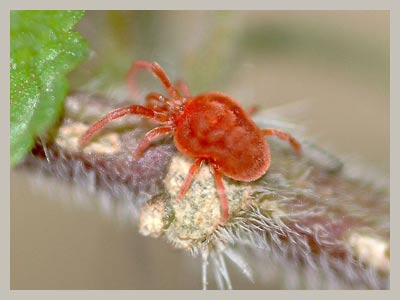
Spider Mites: Spider mites are common microscopic pests of evergreens, which destroy the chlorophyll cells at the surface of the needle or scale of the conifer. As a result of the mite injury, the plant loses its vigor, the leaves can turn brown and defoliate, and may even die. The adult spider mites lay eggs that hatch in the spring, and most of their damage is caused in warmer months. Proper fertilization and watering practices can help keep damage of spider mites to a minimum. If infestation is serious, spider mites can be treated in the summer with a foliar insecticide treatment.